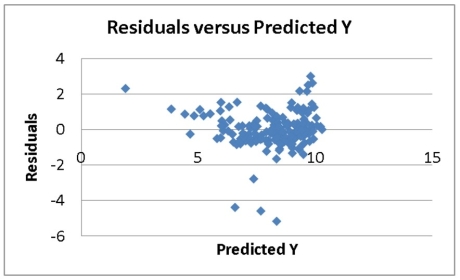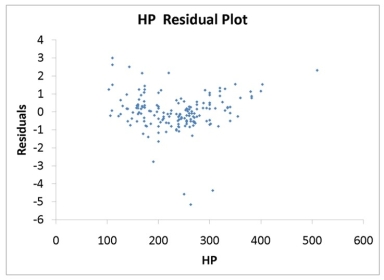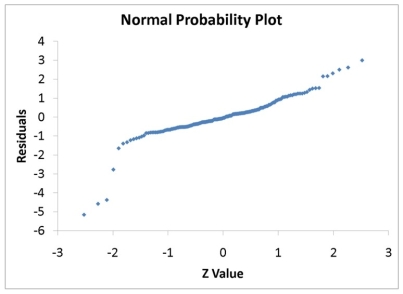TABLE 13-16
What are the factors that determine the acceleration time (in sec.) from 0 to 60 miles per hour of a car? Data on the following variables for 171 different vehicle models were collected:
Accel Time: Acceleration time in sec.
Cargo Vol: Cargo volume in cu. ft.
HP: Horsepower
MPG: Miles per gallon
SUV: 1 if the vehicle model is an SUV with Coupe as the base when SUV and Sedan are both 0
Sedan: 1 if the vehicle model is a sedan with Coupe as the base when SUV and Sedan are both 0
The regression results using acceleration time as the dependent variable and the remaining variables as the independent variables are presented below.

The various residual plots are as shown below.





The coefficient of multiple determination for the regression model using each of the 5 variables Xj as the dependent variable and all other X variables as independent variables (Rj2) are, respectively, 0.7461, 0.5676, 0.6764, 0.8582, 0.6632.
-Referring to Table 13-16, what is the value of the test statistic to determine whether HP makes a significant contribution to the regression model in the presence of the other independent variables at a 5% level of significance?
Definitions:
LTP
Long-Term Potentiation refers to the durable increase in signal transmission strength between two neurons, achieved through their simultaneous stimulation.
Neural Process
The physiological activities through which neurons communicate, leading to brain functions such as thought, memory, and sensation.
Serial Positioning
The tendency to recall the first and last items in a list better than the middle items.
Classical Conditioning
A learning process in which a neutral stimulus becomes associated with a meaningful stimulus and acquires the capacity to elicit a similar response.
Q2: Referring to Table 13-13, holding constant the
Q4: Referring to Table 12-12, the degrees of
Q32: Workers join unions to influence _-related decisions,especially
Q35: Describe golden parachute and platinum parachute practices.How
Q42: Which of the following are shares of
Q72: Referring to Table 13-17 Model 1, the
Q127: Referring to Table 12-10, what is the
Q154: Referring to Table 12-4, the total sum
Q273: Referring to Table 13-7, the value of
Q286: Referring to Table 13-15, what are the